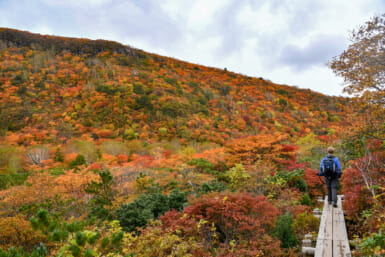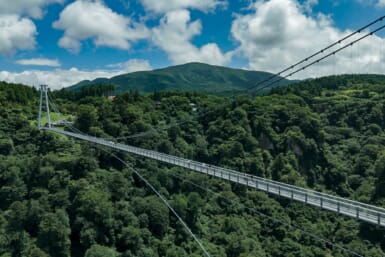by Rick Kennedy
A lesson in sitting quietly
Zen is training to be at every instant sharply aware of the heartbeat of the universe while at the same time remaining relaxed and calm—sort of the consciousness of a happy baby seems to be the ideal. You do this by learning how to empty your mind of every-day preoccupations like itches, sexual throbbing, noises off, anxiety about money and that re-occurring daydream about driving a red Ferrari along the Corniche with an adoring lady at your side.
Adherents to zen say the non-zen mind chases after ideas like a monkey chases after peanuts. Zen is a tough, tough physical and mental discipline with a literature that celebrates embracing the Cosmic Absurd and planting a great wet kiss on its cheek. Zen is about sitting quietly; zen is about nothing at all.
Every Monday evening, the Zen temple of Chokokuji in Nishi Azabu offers an opportunity for the curious to experience something of the discipline of zen. Chokokuji’s is an unstressful initiation: if you seriously petitioned a zen temple to accept you as a monk, you would be kept waiting on the doorstep of the temple in the snow for three days, as a preliminary test of your sincerity.
Chokokuji, founded in 1598, is the Tokyo branch of Eiheiji, the great zen temple in Fukui Prefecture on the Japan Sea, an astonishing place well worth a visit. (The gravel path to the entrance of Eiheiji is lined with cedars planted by the temple’s third patriarch. It is numbing to walk down a path lined with 600-year-old trees a hundred feet tall.)
The Tokyo temple is in the process of adding a new couple of buildings to those already existing: the Kannondo just inside the gate, where anyone can pop in for a quick obeisance to the four-story-high wooden statue of Kannon, the Buddhist goddess of mercy, or just sit for a while on one of the benches donated by Fuji Film along the back wall and inhale the incense; the main building or Hondo, which is built entirely of Japanese cypress—the only such building in the city; and the Zendo, the meditation hall, where you will spend the largest part of the evening.
Present yourself around 6:45 p.m. at the uketsuke, the reception area. Take off your shoes and stow them in the rack in the genkan, the entrance area. Kneel on a cushion before the little writing desk and inscribe your name and address in the temple’s book, then slip a ¥100 coin into the offertory box, which is the only cost of this Little Adventure.
One of the monks will lead you down a dim corridor to a tatami room where you can divest yourself of your socks and your watch and any piece of clothing, such as a tie, that binds. This tatami room has something of the atmosphere of a locker room before an athletic event. The old hands are getting into their various zen-style meditation outfits and warming up with stretching exercises. Some sit immobile looking out of the window at a leafy scene—apparently as content as a bug.
As a neophyte, you will be led back to the reception area to a kind of dentist’s waiting room (stuffed chairs, a rack of newspapers) to wait with the evening’s dozen or so other neophytes for a monk to lead you all to the Hondo for instruction on how to sit and how to move.
The Hondo is a very large tatami room whose roof is supported by carved beams of great nobility. You line up in front of a rank of black, round cushions and listen while a monk explains with great authority how to walk, how to hold your hands as you walk, how to do “gassho” to greet another person, the proper way to care for and sit on your cushion and an alternative way for those who aren’t at this stage quite prepared to sit in the classic zazen position of right ankle on left thigh, left ankle on right thigh, back absolutely straight, hands composed in the prescribed fashion, eyes half closed, breathing regularly with tip of the tongue resting light on the front of the roof of the mouth.
It’s all in Japanese, of course, but it’s all clear enough. At ten minutes before eight, instruction is over and you are excused to go to the bathroom (you should bow to the bathroom shrine before using the facilities) and otherwise prepare to enter the meditation hall.
At precisely eight o’clock you will be summoned into the Zendo. The experienced practitioners are already there in their places on raised tatami mats facing the wall. The neophytes file in, slip on slippers, are given a little sutra booklet, a sutra being a sort of Buddhist psalm (yours will be written in Roman letters.) The monks will show you how to divest yourself of your slippers, do a gassho to the person across the aisle, and in a prescribed movement flip yourself onto your cushion and turn to face the wall.
And there you are, alone with yourself. Thoughts buzz around like mosquitos and you are more uncomfortable than you have ever been in your life. Your knees are on fire. But the room of sixty people is absolutely quiet and as far as you can tell no one has shifted position so much as a millimeter. Gradually you don’t feel your knees any more and your thoughts become fuzzy, drifting, lazy.
You snap back when from the center of the dimly lit room someone begins to speak. It is the teacher, and he talks softly about Great Things with easy pauses between sentences.
Then comes the chanting of the sutra. It is dull and monotonous and goes on and on, but there is a harmony to it. Then a thumping of the huge drum in the corner and the rhythmic clatter of blocks of wood being beaten together, and it is over. You have been sitting for forty minutes, and are slightly stunned by the ritual of it all.
Retreat to the tatami room to reclaim your gear (your watch will say 9 o’clock), and to the entrance to retrieve your shoes, then out into the night. Ha! The world is still here!
If you are in the mood for a bite to eat, 20 meters down the street across from the Fuji Building is a fine little Indian restaurant called Bindi which specializes in home-style cooking.
Chokokuji is at 21-34 Nishi Azabu 2-chome, just around the street across from the Fuji Building, which is a landmark in this part of town. It’s a ten-minute walk from the Omotesando subway exit B-1. Tel: 400-5232.








